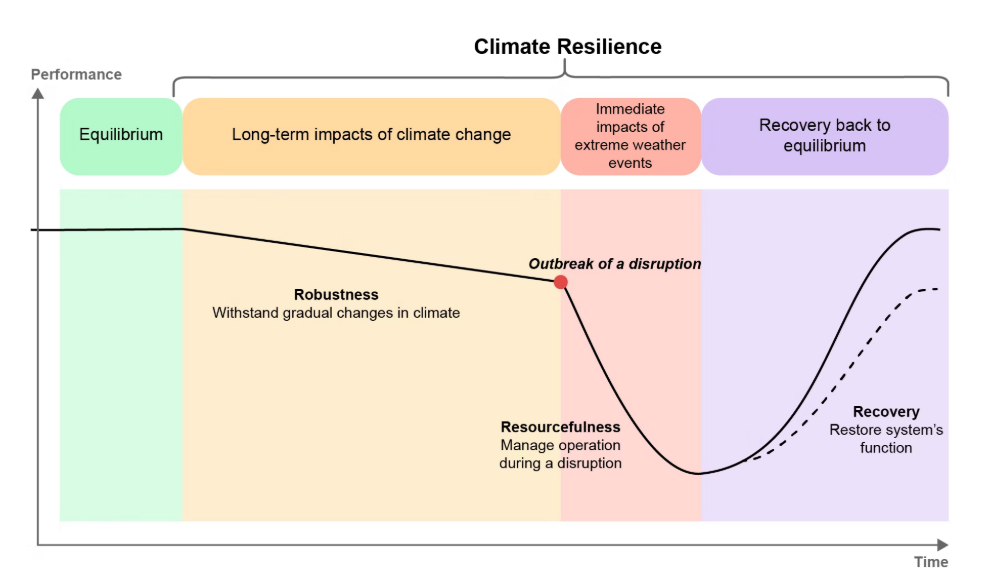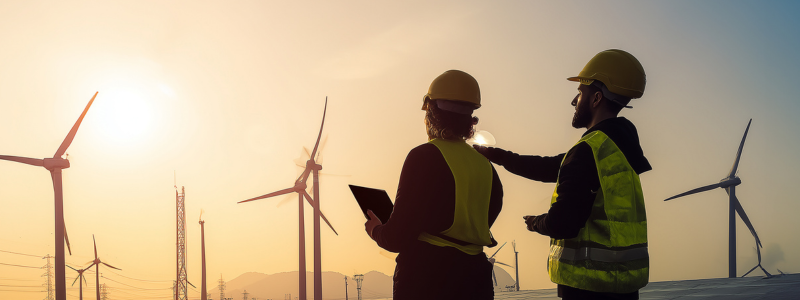Climate resilience is crucial for any business.
As the backbone of the modern economy, the energy sector is uniquely exposed to the impacts generated by extreme weather events resulting from climate change with cascading effect on other industrial sectors, which can directly impact operations, cause damage to property, disrupt supply chains, affect workforce availability and ultimately lead to significant financial losses. Therefore, building climate resilience through adaptation strategies allows businesses to mitigate these risks, maintain operational continuity in a changing climate, and support financial security.
Key reports and strategies consistently emphasise the urgency of climate action. Scientific bodies like the IPCC provide crucial assessments, while policy frameworks, such as Climate-ADAPT in the EU and the National Adaptation Plan (NAP3) in the UK, provide the necessary tools to understand and address climate vulnerabilities.
In this context, businesses must prepare to protect their operations and ensure their long-term viability, sustainability and competitiveness. This means embedding resilience into short-, medium-, and long-term planning by investing in climate-proof infrastructure, adopting nature-based solutions, and strengthening supply chains against climate-related disruptions.
This short article will present the concepts of climate resilience and adaptation, focusing on power systems and making use of the conceptual framework provided by the Argonne National Laboratory in the report titled “Resilience: theory and applications” and the latest edition of the “Power Systems in Transition” report from the IEA (international Energy Agency).
We will outline what key steps businesses can take to increase resilience and adapt to a changing climate, and how Airbus Protect can be your trusted partner on this journey.
What is climate resilience?
Climate resilience refers to the ability of systems, communities and organisations to anticipate, absorb and recover from the effects of climate related hazards. It involves the capacity to withstand sudden shocks, such as extreme weather events, as well as long-term stresses, like changing in precipitation patterns and rise in temperatures.

Figure 1: Argonne National Laboratory (2012), Resilience: Theory and Applications (ANL/DIS-12-1), as modified by International Energy Agency.
In “Resilience: theory and applications”, the importance of integrating resilience into the planning and operations of critical infrastructure is emphasised. The process proposed in the report involves identifying the vulnerabilities, developing mitigating strategies and adapting the decision-making process to reduce the impact of the extreme events and increase the pace of recovery. The main message conveyed in the report is the need for businesses to have an integrated and comprehensive approach to resilience paying particular attention to the interdependencies between different systems and stakeholders.
The Role of Adaptation in Climate Resilience
While resilience focuses on preparation and recovery from the impact of climate change, adaptation involves taking steps to reduce the vulnerability and strengthen the resilience of the business operations to those impacts. Adaptation measures can include, but are not limited to, upgrades to infrastructure, relocation and/or distribution of activities, development and adoption of new technologies.
The IEA’s Power Systems in Transition report underscores the importance of adaptation for the energy sector where climate change poses a significant risk. This is much more important as the energy sector is relied upon by other industries. The report emphasises the need for co-ordinated action among policy makers, industry and other stakeholders to build a more resilient energy sector. This is because while the power sector has a direct interest in providing a reliable service, the investments needed tend to have a visible benefit years after the capital expense. Market conditions in many countries do not incentivise the investment, and the cost of disruption is only in part shouldered by operators and generators.
How to build Climate Resilience in Business?
For businesses looking at building climate resilience, a multy-faceted approach that requires constant commitment is required. Here are some key steps businesses can take:
- Strategic Planning: Integrate climate resilience into business operations by strategic planning including short and long term objectives to mitigate the risks identified.
- Policy Definition: Considering the PDCA cycle (Plan, Do, Act, Check) it’s important to ensure businesses incorporate adaptation into decision-making processes.
- Risk Assessment: Conduct a comprehensive climate impacts and risk analysis to identify climate-related vulnerabilities. This step, which is intended to be regularly repeated, is critical and involves evaluating the impact of different climate hazards and extreme weather events on operations, infrastructure and supply chain in relationship with the business data.
- Investment in Adaptation: Allocate adequate resources to initiatives that increase the resilience of infrastructure and operations. This can include upgrading facilities to withstand extreme events, diversifying supply chains, introducing systems redundancies and implementing sustainable initiatives.
- Collaboration and Partnerships: Partnerships can help leverage collective strengths and build a more resilient ecosystem. It is important to collaborate with other businesses in the same industry and in the same geography as they will be facing similar challenges. Local and national governments, and communities can pool resources, establish priorities and share best practices.
- Continuous Improvement: The resilience strategies need to be regularly reviewed and updated to reflect the changing climate conditions and emerging risks. Continuous improvement ensures that businesses remain prepared for future challenges.
- Employees Awareness: Internal stakeholder awareness is important when adapting to climate change because it helps foster a culture of sustainability within the organisation, encourages collaboration and commitment to environmentally friendly practices, and ensures alignment with climate change goals and regulations.
How Airbus Protect Supports Climate Resilience
Airbus Protect can assist your company to boost its business resilience thanks to a dedicated team of consultants offering a range of activities:
- Resilience and adaptation
In this context, Airbus Protect is undertaking several climate resilience and adaptation projects for the aviation and industrial sectors.
An example of projects related to aviation can be aimed to enhance the understanding of available climate models to facilitate the selection of the most appropriate options based on geographical areas, technical activities, and specific weather phenomena by creating a database analysing main climate models and identifying key players in this field. For airlines and airports, a key effort builds upon a study analysing past and future climate trends at major airports to understand weather-related cancellations and extreme events. This foundational work aims to develop comprehensive climate change adaptation services, which includes creating a data modeling method to predict future disruptions based on both traffic and weather data, and a detailed methodological report.
Complementary to this broader service development, Airbus Protect may conduct specific climate change risk and disruption assessments for individual airlines. This involves a quantitative analysis, airport by airport, to estimate the frequency and intensity of weather events and their operational and financial impacts (on flights, passengers, and revenue). The ultimate goal for these tailored assessments is to provide a data-driven toolkit, including risk maps at the airport system level and detailed reports on physical, operational, and financial impacts, to support the airline’s decision-making and the development of a robust climate change adaptation plan, also considering stakeholder engagement on decarbonisation and adaptive solutions.
Airbus Protect has a strong background in risk management. Combined with its climate change and sustainability expertise, Airbus Protect state-of-the-art analysis summarises key actors, available tools, associated costs, bespoke methodologies for climate resilience assessment and adaptation solutions for major clients in sectors such as Energy, Industrial, Defence, Nuclear, and Aerospace. Airbus Protect actively monitors the latest regulatory trends and frameworks across Europe to support the resilience of its customer base.
- Training and Awareness
Complementary to these projects, Airbus Protect also offers activities to enhance understanding of climate change and its impacts through training and awareness. Continuous training and development are crucial to ensuring teams are aware of climate related risks and can work effectively to increase the business resilience and complying with relevant regulations. Our Climate Fresk is one example of this. It is a collective intelligence workshop, enabling everyone to understand how climate change works, and the scale and complexity of the issues involved, so that they can take ownership of them and take action.


